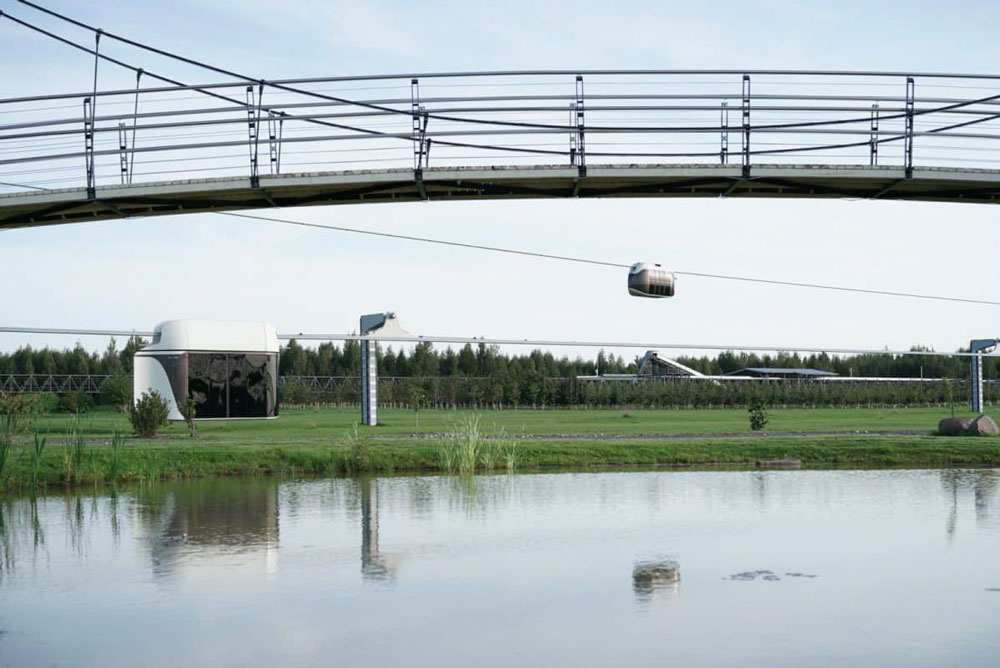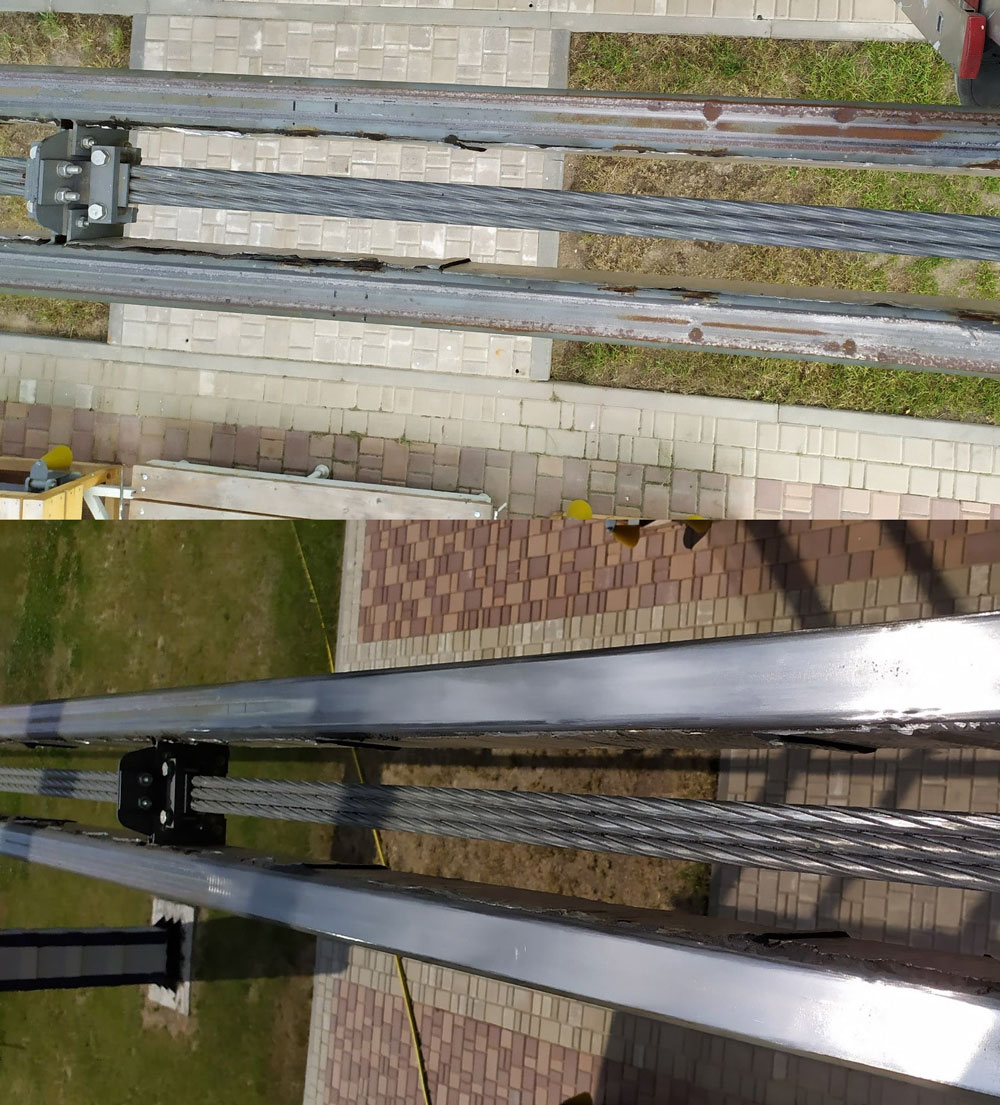

The lifespan of the string rail overpass of the uST transportation and infrastructure complex is 50 years. It is maintenance-free and very reliable structure. However, what if the overpass requires repair? For this situation, the experts at UST Inc. have devised a streamlined and efficient method for the restoring of prestressed steel structures subjected to continuous dynamic forces. This technique is particularly useful for the restoration of the string rail raceways and bodies.

Unimobiles undergoing tests at the EcoTechnoPark, Maryina Gorka (Belarus), 2020.
In the process of installation and maintenance of the transportation systems, it is not uncommon for track components to sustain damage. For example, if a rail unmanned vehicle slips during testing in different modes, scratches may appear on the surface of the rail, which could negatively affect traffic safety.
During the regular maintenance of railway tracks, any defects are repaired by grinding or replacing the damaged sections. However, these methods are not suitable for string rails. The raceway is made of a particularly strong alloy steel with a small thickness, and deep grinding could reduce the strength of the structure. Replacing an element involves complex calculations and requires de-stressing the section, which can be time-consuming and expensive.
If it is not possible to replace or repair the damaged area, the engineers have proposed welding metal onto it. This method seems simple at first, but it requires careful selection of the right electrode and strict adherence to welding techniques in order to achieve a strong metal joint. If this is not taken care of, the deposited layer may become detached.

Section of track structure before and after repair, Maryina Gorka, 2020.
Before starting work, it is necessary to mechanically remove the zinc coating from the defect site, and then heat the surface using a gas burner or hot air gun to 80–100°С. The electrodes are being heated at a temperature of 320-350°C for two hours, after which they are stored in a heated quiver.
Arc surfacing is done in layers until the design thickness is achieved. It is important to ensure that the temperature between the layers does not exceed 150°С, and after the work is complete, the deposited metal should cool down to 40-50°С. Subsequently, the surface is inspected for any cracks or imperfections, and then it is grinded, cleaned, and treated with a zinc-rich compound.
The technology proposed by Belarusian engineers allows for quick and reliable rail repair without the need for highly specialized technicians. All that is required is knowledge of steel specifications and a skilled welder. In EcoTechnoPark (Maryina Gorka), these sections have been operating without any complaints for more than five years. The repair site is not visible to the naked eye and requires specialized knowledge to locate.
This form asks for your consent to allow us to use your personal data for the reasons stated below. You should only sign it if you want to give us your consent.
Who are we?
The name of the organisation asking you for consent to use your information is:
Global Transport Investments
Trident Chambers, P.O. Box 146, Road Town
Tortola
British Virgin Islands
We would like to use the following information about you:
Why would we like to use your information?
Global Transport Investments would like to send this information to company registry, inform you about its news, for refund purposes.
What will we do with your information?
We store your name, address, ID Data, date of birth into company registry. We will share your e-mail & phone number with IT Service (https://digitalcontact.com/), SMS Center (http://smsc.ru). They will add your details to their mailing list and, when it is news update, they will send you an email or sms with details. We store your credit card number for possible refunds.
How to withdraw your consent
You can withdraw the consent you are giving on this form at any time. You can do this by writing to us at the above address, emailing us at the address: [email protected] or by clicking on the unsubscribe link at the bottom of emails you receive.
This privacy notice tells you about the information we collect from you when you sign up to receive our regular newsletter via our website. In collecting this information, we are acting as a data controller and, by law, we are required to provide you with information about us, about why and how we use your data, and about the rights you have over your data.
Who are we?
We are Global Transport Investments. Our address is Trident Chambers, P.O. Box 146, Road Town, Tortola, British Virgin Islands. You can contact us by post at the above address, by email at [email protected].
We are not required to have a data protection officer, so any enquiries about our use of your personal data should be addressed to the contact details above.
What personal data do we collect?
When you subscribe to our newsletter, we ask you for your name and your email address.
Why do we collect this information?
We will use your information to send you our newsletter, which contains information about our products.
We ask for your consent to do this, and we will only send you our newsletter for as long as you continue to consent.
What will we do with your information?
Your information is stored in our database and is shared with with IT Service (https://digitalcontact.com/), SMS Center (http://smsc.ru). It is not sent outside of the Euro. We will not use the information to make any automated decisions that might affect you.
How long do we keep your information for?
Your information is kept for as long as you continue to consent to receive our newsletter.
Your rights over your information
By law, you can ask us what information we hold about you, and you can ask us to correct it if it is inaccurate.
You can also ask for it to be erased and you can ask for us to give you a copy of the information.
You can also ask us to stop using your information – the simplest way to do this is to withdraw your consent, which you can do at any time, either by clicking the unsubscribe link at the end of any newsletter, or by emailing, writing us using the contact details above.
Your right to complain
If you have a complaint about our use of your information, you can contact the Information Commissioner’s Office.
Rate and Comment
You can assess the importance of a particular publication and the level of its preparation. Share your opinion in the comments!